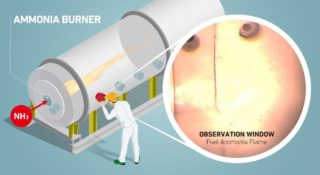-
Mitsubishi Power to develop ammonia combustion systems for thermal power plant boilers
Date posted:
-
-
-
Post Author
Greg Kelsall
-

Mitsubishi Power plans to develop combustion equipment that can utilise ammonia (NH3) as a fuel, that does not emit carbon dioxide when used in power generation. By allowing the use of ammonia as an alternative to coal and other fossil fuels normally used in thermal power stations, this system will support the decarbonisation of thermal power generation.
As reported by Argus Media recently, Japan’s trade and industry ministry (Meti) has proposed a new target to finalise development of a coal burner that can co-fire ammonia at above 50% in the fuel mix, and of a fully ammonia-fired gas turbine by 2030. Meti wants to complete a demonstration project for the ammonia co-fired burner and ammonia-fired gas turbine at operating power units by 2029/2030, ready to start commercial installation from 2030.
Mitsubishi Power conducted combustion tests at the MHI Research & Innovation Centre using basic combustion test furnaces that can simulate the combustion conditions of coal-fired boilers in power stations. These tests were used to compile basic data on ammonia and coal co-firing and ammonia-exclusive firing. The company has also identified optimal systems and conditions for combustion after understanding the characteristics of ammonia firing. These include the generation of nitrogen oxides (NOx) which is a concern for ammonia firing, and the potential for unreacted residual ammonia to be released outside the power generation system.
Mitsubishi Power recently conducted combustion tests for ammonia and coal co-firing and 100% ammonia firing using a small-scale combustion test furnace. Several types of burners were tested, based on extensive burner design experience and the result of basic tests, with the aim of supplying 100% ammonia burners to utility and industrial boilers in Japan and overseas. These tests confirmed that flames remained extremely stable during combustion, as NOx emissions were as specified by the basic combustion test target, and there was no residual ammonia.
These ammonia burner combustion tests are described as the first step toward the development of combustion equipment. Based on the results, Mitsubishi Power will demonstrate the technology using a full-sized combustion system and take steps to implement the technology at an existing facility, with the aim of gradually introducing ammonia fuel to the industry.
